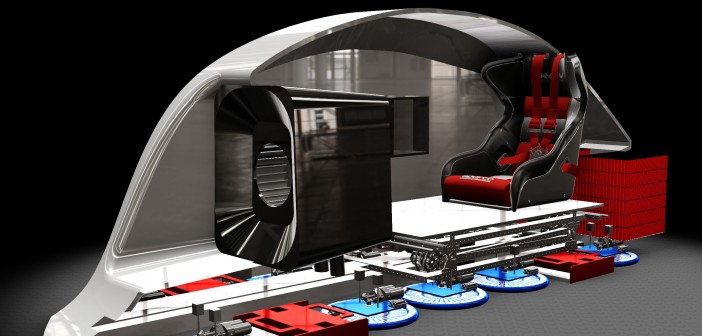Lehigh’s Hyperloop team and their design for a 500 mph pod has made it to the next phase of the SpaceX Hyperloop Pod Competition, which is tentatively scheduled for June.
Seamus Cullinane, ’17, a member of the team, said the competition started out with 1,200 teams from around the world. During the preliminary round, those numbers were cut down to 300, and of those only 120 were asked to go to Texas at the end of January to present their designs. Lehigh’s design not only landed them a spot in Texas but also in the top 10, along with schools like MIT, and pushed Lehigh into the next portion of the competition.
According to member Correll French, ’17, Lehigh’s design was unique not only because of its speed but also its more practical, user-friendly approach. French said many of the other designs were “pretty, (but) not practical,” whereas Lehigh’s team aimed to make their invention one that would be efficient and enjoyable. Lehigh’s team designed a handicapped accessibility system, something that no other school did, which set them apart from the rest.
Lehigh’s success, according to French, was surprising for many of the schools that they competed against, and their booth became one of the most talked about at the competition.
“A lot of teams wrote us off,” French said. “Yes, we’re known for engineering, but we’re seen as more consulting engineers, business engineers. Rather than inventors, we’re the problem solvers. But it was nice to be here and say ‘Well yeah, we’re the problem solvers, but we solved our way to a good invention.’”
For the next month, the team will spend its time improving their design in collaboration with the two engineers that will be provided by SpaceX. Each team advancing in the competition is given these engineers to provide feedback on the safety concerns and logistics of the design before approving the team to start building.
Until that approval comes in, French said the three main goals of the team are to focus on media, recruitment and sponsorship.
Cullinane refers to this project as a “full-time job,” estimating that he and other members of the team spend around 20 to 30 hours a week on the project while still keeping up with their school work and other extra curricula. Although they already have a team of committed workers that got them this far, the manpower that it would take to build their design in the allotted time frame is way beyond their capabilities without taking in extra help.
The team hopes to recruit around 100 people to help with the building of their design.
“(We’re looking for) any time commitment, as long as it’s consistent,” French said. “Doesn’t matter if it’s a half hour or 100 hours.”
The team also needs to raise upwards of $50,000 to complete the project. Not only does the pod need to be built, but also Lehigh has to create a track in which to test their invention before using the SpaceX track, to ensure that any malfunctions won’t damage the presentation track.
Because of this, the team plans on reaching out to Lehigh’s community for anyone who wants to be part of the project. In addition to contacting corporate sponsors such as Goldman Sachs and Kurt Lesker, but is also asking Lehigh students and alumni to help where they can.
Kyle Higgins, ’18, who is in charge of the team’s media outreach, said his goal is to ensure that people are updated and to have members of the Lehigh community feel like they are in this project together. Higgins said the university and President John Simon have been incredibly supportive throughout this process.
“It’s a really big deal for Lehigh,” Higgins said. “This is one of the things that makes Lehigh great as a school and it’s a once in a lifetime opportunity.”






Comment policy
Comments posted to The Brown and White website are reviewed by a moderator before being approved. Incendiary speech or harassing language, including comments targeted at individuals, may be deemed unacceptable and not published. Spam and other soliciting will also be declined.
The Brown and White also reserves the right to not publish entirely anonymous comments.
7 Comments
500mph? The test track that the team will be competing on is only a mile long. So when you factor in braking this is very improbable, requiring a heavy amount of acceleration. Unless 500mph is a general statement that the team is throwing out there, but will really be going 100-200mph during the competition.
Hi Nick, I am the design lead for the team. We should be able to reach just under 500 mph. We have our own propulsion system that we are working on as well as the SpaceX provided “pusher.” Together they will provide ample force to get the pod up to speed in about 800 meters. At which point we have a multitude of breaking systems that in conjunction can stop the pod in a mere 6-7 seconds from top speed. Not all teams elected to have a propulsion system of their own and this is one of the reasons we think we can win. If you have specific questions about the design please feel to reach out to us on our website Lehigh.edu/~inhyper
How do individual alumni contribute?
Hi Matt, We have started a crowd funding page on Lehigh’s own IgniteLU: http://ignite.lehigh.edu/hyperloop
Hi Matt, You can donate through our ignite page: http://ignite.lehigh.edu/hyperloop
Please provide a link to the kickstarter or whichever way is chosen to receive outside contributions. Congrats to this motivated team of Lehigh engineers.
Hi Scott, Thanks for your interest! We have a crowd sourcing page through Lehigh: http://ignite.lehigh.edu/hyperloop
You can also visit our website to find out more about the team and our design: Lehigh.edu/~inhyper